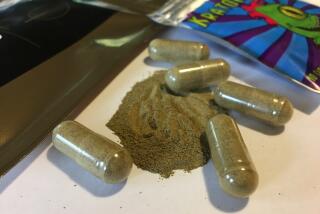
It was the late 1980s when Gary Mund felt his pinky tremble. At first it seemed like a random occurrence, but pretty quickly he realized something was seriously wrong.
Within two years, Mund — a crew worker with the Eastern Municipal Water District in Riverside County — was diagnosed with Parkinson’s disease. The illness would eventually consume much of his life, clouding his speech, zapping most of his motor skills and taking away his ability to work and drive.
“It sucks,” said Mund, 69. He speaks tersely, because every word is a hard-won battle. “I was told the herbicide wouldn’t hurt you.”
The herbicide is paraquat, an extremely powerful weed killer that Mund sprayed on vegetation as part of his job from about 1980 to 1985. Mund contends the product is responsible for his disease, but the manufacturer denies there is a causal link between the chemical and Parkinson’s.

Paraquat is manufactured by Syngenta, a Swiss-based company owned by the Chinese government. The chemical is banned in at least 58 countries — including China and Switzerland — because of its toxicity, yet it continues to be a popular herbicide in California and other parts of the United States.
But research suggests the chemical may cross the blood-brain barrier in a manner that triggers Parkinson’s disease, a progressive neurodegenerative disorder that affects movement. Now, Mund is among thousands of workers suing Syngenta seeking damages and hoping to see the chemical banned.
Aggressive and impactful reporting on climate change, the environment, health and science.
Since 2017, more than 3,600 lawsuits have been filed in state and federal courts seeking damages from exposure to paraquat products, according to Syngenta’s 2022 financial report.
“Despite decades of investigation and myriad epidemiological and laboratory studies, no scientist or doctor — whether or not affiliated with Syngenta — has ever concluded in a peer-reviewed scientific analysis that paraquat causes Parkinson’s,” the company’s chief communications officer, Saswato Das, wrote in an email.
Some scientists contend they commonly use paraquat to induce Parkinson’s disease in mice as part of research studies, said Ray Dorsey, a professor of neurology at the University of Rochester in New York and the author of “Ending Parkinson’s Disease.”

“There have been numerous academic researchers over the last 20-plus years — and multiple different investigators in multiple different locations — that have found that paraquat, when fed to laboratory animals, reproduces the features of Parkinson’s disease,” Dorsey said.
He said paraquat has been shown to damage mitochondria — the energy-producing components of cells — and damaged mitochondria have been implicated in the likely environmental and genetic causes of Parkinson’s.
He referenced an oft-cited 2011 study funded by the National Institutes of Health that found a strong association between Parkinson’s and paraquat. It found that workers exposed to paraquat had a 250% greater risk of getting Parkinson’s disease than people not exposed to the chemical. “Because paraquat remains one of the most widely used herbicides worldwide, this finding potentially has great public health significance,” the study concluded.
The booming popularity of countertops made of engineered stone has driven a new epidemic of silicosis, an incurable lung disease, researchers have found.
Currently, an estimated 1 million people in the United States are living with Parkinson’s disease, which has no known cure. California is home to a high incidence of cases, with large clusters found in agricultural regions where herbicides are heavily used, including Kern, Kings, Merced and San Joaquin counties, according to a 2022 geographic study.
Dorsey and other researchers conceded that, as with cancer and other diseases, it can be difficult to isolate the precise cause of a patient’s Parkinson’s. Outdoor workers may have been exposed to several chemicals and environmental toxins over the course of their careers.

“Yes, people are exposed to several different chemicals, but we try to control for that in epidemiology studies as best we can,” said Jeff Bronstein, director of the Movement Disorders Program at UCLA who has studied the link between paraquat and Parkinson’s in California’s Central Valley. That the animal studies are done by different labs “adds to what we call biological plausibility. It all supports that paraquat increases the risk of developing Parkinson’s disease.”
A jury has awarded $332 million to a man whose suit against Monsanto contended that his cancer was related to decades of using its Roundup weedkiller.
Groups such as Earthjustice and the Michael J. Fox Foundation have been pushing for years to ban paraquat, with the latter noting on its website that the herbicide is “thought to increase Parkinson’s risk by 100 to 500% , depending on overall exposure.”
Paraquat is 28 times more toxic than another controversial herbicide, Roundup, according to a report from the Pesticide Action Network. (Roundup has been banned in several parts of California, including a 2019 moratorium by the Los Angeles County Board of Supervisors forbidding its use by county departments.)
Paraquat also has other known health effects. It is listed as “highly toxic” on the U.S. Environmental Protection Agency’s website, which says that “one small sip can be fatal and there is no antidote.” The EPA is currently reviewing paraquat’s approval status.

However, both the EPA and Syngenta cited a 2020 U.S. government Agricultural Health Study that found no clear link between paraquat exposure and Parkinson’s disease. A 2021 review of reviews similarly found no causal relationship.
Dale Sandler, senior author of the 2020 study, said the researchers observed licensed pesticide applicators and their spouses from Iowa and North Carolina over the course of several years. The study found a 9% increase in the relative risk of Parkinson’s disease incidence associated with using paraquat, which she said was “not statistically significant.”
However, paraquat was significantly associated with the disease among those who reported a history of head injuries, with a more than threefold increase in risk based on a small number of cases with both exposures, said Sandler, who is also head of the epidemiology branch at the National Institute of Environmental Health Sciences.
Multiple sources said the dizzying array of competing research is a reflection of industry pushback, political lobbying and deep-pocketed agribusiness. Syngenta reported a record $33 billion in sales in 2022. One leading researcher on the matter said she has been retained as a witness in pending lawsuits and so was not comfortable commenting publicly for this report.

But the overall findings point in one direction, said Michael Okun, director of the Norman Fixel Institute for Neurological Diseases at the University of Florida. “The collective evidence really points to a serious problem and an emerging association with paraquat that just keeps getting stronger and stronger over time,” said Okun, who is also a medical advisor with the Parkinson’s Foundation, a national nonprofit organization.
For the record:
12:46 p.m. Dec. 20, 2023An earlier version of this article said documents were unveiled as part of ongoing court proceedings in Illinois. The proceedings are in California.
Documents unveiled as part of ongoing court proceedings in California show that Syngenta has spent decades investigating the potential side effects of its product. This research has sometimes contradicted public statements issued by the company, a difference first reported by the Guardian. This includes the 2011 study that showed a 250% increase in disease incidence among workers exposed to paraquat.
In a 2022 deposition, Syngenta’s principal science advisor, Philip Botham, acknowledged that the company made a considerable effort to obtain the data used in that study and conducted its own analysis, which reached the same conclusion about the incidence of the disease, according to a transcript of his testimony. However, the finding was not publicized and Botham did not divulge it in a subsequent interview with the New York Times.
Another transcript indicates that Syngenta attempted to downplay studies showing that paraquat administered to mice caused a reduction in the number of dopamine cells in the substantia nigra, the part of the brain that produces dopamine, which is another hallmark of Parkinson’s disease.
In 2003, a Syngenta scientist, Louise Marks, attempted to replicate those mice studies but found no such reduction in dopamine. However, she expressed concerns about potential shortcomings in her methodology, according to Botham’s testimony. Marks then traveled to California, where a Syngenta consultant taught her an improved methodology, after which she repeated the study multiple times and did indeed find a reduction in dopamine cells.
Despite Marks’ concerns, Syngenta publicized her original findings at an annual meeting of the Society of Neuroscience in 2004, Botham testified. Syngenta did not publish all of her updated studies or report her reservations to the EPA, he said.
Das, of Syngenta, dismissed the 2011 study as an “interim study that looked at only part of the data,” adding that the findings were later expanded upon and improved in the 2020 study that found no clear link.
Regarding dopamine loss in mice, he said the animals in those studies were given doses “as much as 22,000 times higher than the highest amount of exposure found in U.S. farmers” and that animal studies cannot be used to prove causation. He said the majority of Marks’ findings were not reported to the EPA because they were materially similar to what was already in the public literature.
“In short, the hypothesis that paraquat causes Parkinson’s is not accepted in the medical community or peer-reviewed science, nor has it been accepted at any time in the past,” he said.
DDT was banned 50 years ago, but its toxic legacy continues to affect the California marine ecosystem and threaten various animal species.
Still, Syngenta has paid at least $187.5 million into its settlement fund as of 2021, according to its financial report. One attorney involved in California litigation estimated that there are at least 300 active plaintiffs in the state and at least 4,500 in the country.
Chevron is also named as a defendant in many cases, because the company distributed paraquat in the U.S. from the mid-1960s to the mid-1980s before abandoning the product.
In Mund’s legal complaint, attorneys ague that the companies “failed to warn that paraquat was likely to cause neurological damage that was both permanent and cumulative, and repeated exposures were likely to cause clinically significant neurodegenerative disease, including Parkinson’s disease.”
Officials with Syngenta, however, said the endless stream of litigation is the product of a “mass tort machine” generated by law firms with profit motives. At one time, they said, there were commercials airing on television every six minutes seeking plaintiffs or people who may have a claim to injury.
In California, at least, the debate rages on.
Last year, half a dozen researchers, including Okun and Dorsey, signed a letter to the California Department of Pesticide Registration urging it to reconsider use of the chemical. The letter warned that “paraquat presents a public health hazard to residents and workers in the state of California.”
The letter was among more than 4,600 comments submitted to the agency last year related to the use of paraquat in the state — including some that cited more than 70 news articles and 40 scientific studies regarding potential human health and ecological toxicity, according to department officials.
“DPR continues to evaluate the data associated with the public comments on paraquat dichloride renewal and plans to issue a response after considering the comments and available information,” wrote Tulio Macedo, chief of the pesticide registration branch, in the agency’s most recent semiannual report in September.
At the same time, federal legislation has been introduced that seeks to ban paraquat in the United States. That includes the proposed Protect America’s Children from Toxic Pesticides Act of 2023, introduced by Sen. Cory Booker (D-N.J.).

For people such as Mund, who was diagnosed with Parkinson’s in 1990, such decisions can’t come soon enough.
He and his wife, Tammie, recently moved to Sparks, Nev., to be closer to their kids and grandkids.
The couple have been married for 50 years — not all of which have been easy, as the disease has taken a financial toll on the family as well as a physical and emotional one, Tammie said. Among other treatments, Mund has had two brain surgeries and now has a deep brain stimulation implant to help him control his symptoms.
“It’s been a long-term process,” Tammie said as she pointed to a fresh scab on her husband’s scalp from a recent fall.
Mund said he has no relatives with Parkinson’s and that a medical test confirmed his case was not genetic. But he did have a co-worker who was also diagnosed with Parkinson’s and later died, he said.
“They banned DDT back in the ’60s,” Mund said, asking why the same hasn’t happened for paraquat.
He said he experienced a lot of anger in the early years after his diagnosis, but he’s mostly come to terms with it. However, he still wishes he could ride his motorcycle one last time, he said.
His wife has a different wish.
“We’d like to see it banned,” she said.











